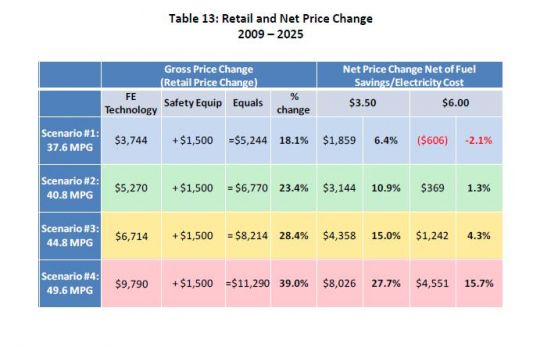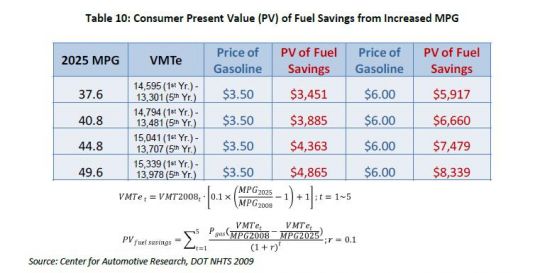The more you look at it, the better the 54.5 MPG standard unfurled by the White House looks.
As reported earlier, the White House and several car makers showed off a proposed standard last week that would require auto manufacturers to hit a fleet average of 54.5 MPG by 2025 for cars and light trucks. Car makers currently are at a 28.3 MPG average and need to hit 34.1 MPG by 2016. (See our story on ten technologies that will help automakers hit the new standards.)
Some fear that the standards will add costs to cars. The Center for Automotive Research in a recent report said that the standards could add $11,290 to the cost of cars in 2025 with a net-net cost to consumers (higher car price plus electricity minus saved gas) of around $4,500 to $8,000 in a worst-case scenario. CAR is more skeptical than most. The Boston Consulting Group projects that it might add $2,000 to the price of cars.
But when you dig into CAR's numbers -- the crucial ones are in Table 13 on page 39 -- you begin to see a different picture.
The regulations would save you money.
First, here’s Table 13. (The story continues below the table.) The first column lists different mileage proposals. Scenario #1 calls for MPG averages of 37.6, which would be achieved with a CAFE mandate of 47 MPG. Number 2 (40.8 MPG) is equivalent to a 51 MPG federal mandate. Number 3, 44.8 MPG, is equivalent to a 56 MPG standard, or similar to the one proposed by Obama.
As the chart shows, a 44.8/56 MPG standard would add $6,714 to the raw cost of a car. Note: this estimate averages the sticker price of electrics, hybrids and gas cars. If you want to know what happens to gas cars, look at scenario #1, which includes fewer EVs. Lower MPG mandates would likely mean fewer electrics in the overall factory output. There, the additional costs come to $3,744.
CAR then adds $1,500 for additional safety costs. The safety costs, however, largely revolve around “accident avoidance” technologies like forward collision detection and ejection mitigation. (See pages 25-27 of the report.) Only a few of these technologies -- quieter cars, glazing -- seem directly related to MPG.
Some of these safety features will impact mileage, but only a little. Most of these functions will be handled by software and hardware, which require very little energy and are getting more energy efficient all the time.
Thus, these factors can be thrown out for purposes of this article. CAR is correct: these safety features are likely inevitable. Accident avoidance technologies will get incorporated into cars. But you could make higher-mileage cars without the $1,500 added costs and without the additional safety features. You don’t need one to get the other. And some will be sold as options, not as mandatory equipment. Thus, to estimate the cost of MPG goals, we took them out for these equations.
Tables 10 and 11 (see below) talk about how much gas would be saved under the new plans and how much electricity consumers would buy over a five-year period. But there’s an easier way to get to the answer. Go back to Table 13 and subtract $1,500 from each of the net-net savings scenarios on the right-hand side of the chart.
Under the 44.8/56 MPG scenario, consumers will spend $2,858 more on cars, fuel and electricity over a five-year period if gas costs $3.50. (That figure is arrived at by subtracting $1,500 from $4,358.)
However, under a scenario where gas costs $6, consumers will spend $258 less ($1,242 minus the nice-but-extraneous-for-this-debate $1,500).
And again, this is over five years. If you own the car for seven years, your out-of-pocket costs drop by $642 ($874 in gas savings minus $202 in electricity) to bring the total extra costs down to $2,216 in the $3.50-a-gallon gas world of 2025.
If gas costs $6 a gallon in 2025, you now save $3,047.
We don’t know if gas will hit $6, but considering it’s already at $4 in some parts of the country, it’s a more likely price point.

Again, the 44.8/56 MPG figures include electric cars. Scenario #1 is closer to what will happen in gas cars. In that situation, drivers only spend $359 in a “$3.50 gallon gas in 2025” world and save $2,106 if gas hits $6 when you take out the accident avoidance charges.
And, again, that’s over five years. An additional few months past that puts drivers in the black under either scenario.
Think of the Tea Party rallies you could throw with all that extra money.
Can Detroit pull this off, save consumers money and improve cars? It could, as Dan Sperling at UC Davis and others have pointed out: a mid-'80s Ferrari has the same acceleration as a modern Toyota RAV4. It certainly would dent the ratings of any remake of Magnum P.I. if Magnum had to drive a family SUV. Automakers have put nearly all of their R&D into performance, not economy. A slight regulatory tweak could get them to turn their engineering talents toward a different goal.




